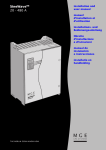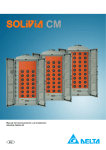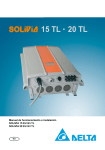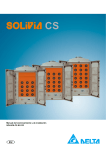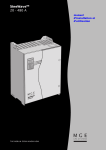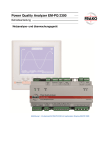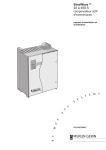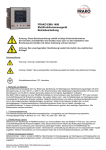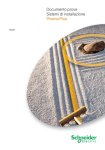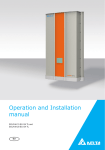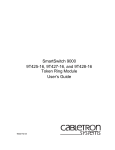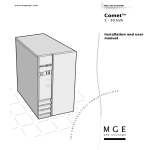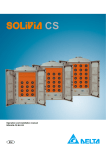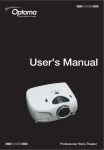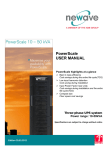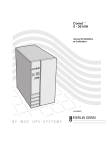Download installation and user manual SineWaveª 20
Transcript
SineWaveª 20 - 480 A OSF active harmonics conditioner installation and user manual To the user We would like to thank you for choosing the OSF active harmonics conditioner and welcome you to the ever increasing world-wide family of satisfied FRAKO product users. This manual has been written to provide you with all the information necessary to install and operate your OSF active harmonics conditioner. We remain at your entire disposal should you require any further details. FRAKO Kondensatoren- und Apparatebau GmbH Tscheulinstr. 21a l D-79331 Teningen l Germany Phone +49 7641/453-0 l Fax +49 7641/453-545 http://www.frako.de l E-Mail: [email protected] advice for safety Danger: dangerous voltages are present inside the conditioner. Any intervention requiring the door or protection panels to be opened must be carried out by qualified personnel; n the conditioner must be earthed; n do not place the conditioner near liquid or in an excessively damp environment; 0 n do not obstruct the air vents; n do not place the conditioner in direct sunlight or near a source of heat; n if the conditioner in stored before use, it must be kept in a dry place. Storage temperature: between -20°C and +45 °C; installation and operation manual of OSF n do not store horizontally; n dispose of packing waste in compliance with legal provisions in force. FRAKO GmbH contents identification .................................................................................................. 3 standards ......................................................................................................... 3 principle improvements offered by OSF ........................................................................... 4 operating principle .................................................................................................. 4 device functional features ...................................................................................... 4 installation standard arrangements ........................................................................................ installing device(s) ................................................................................................ mechanical characteristics ...................................................................................... installation requirements ......................................................................................... connecting power .................................................................................................... connecting dry contacts and communication port (optional) ................................... connecting ribbon cables for 120 A and parallel installation ................................... moving the graphic terminal .................................................................................... installing current sensors .................................................................................... sensor mechanical and electrical characteristics .................................................... mounting direction of sensors ................................................................................. installing sensors .................................................................................................... connecting sensors ................................................................................................. 5 7 7 8 9 19 20 21 21 21 23 23 26 energization and de-energization energizing .............................................................................................................. general ................................................................................................................... starting the OSF conditioner ............................................................................... stopping the OSF conditioner ............................................................................. de-energizing ......................................................................................................... 27 27 27 27 27 operation signification of indicator lights ............................................................................ control and monitoring interface ......................................................................... presentation ............................................................................................................ operation ................................................................................................................. general menu .......................................................................................................... choice of language .................................................................................................. displaying main measurements .............................................................................. displaying secondary measurements ...................................................................... displaying alarms .................................................................................................... configuring .............................................................................................................. J-BUS communication ............................................................................................ identification ............................................................................................................ RUN-STOP controls ................................................................................................ reserved access ...................................................................................................... 28 29 29 29 29 30 30 31 32 33 34 34 34 34 maintenance .................................................................................................... 35 what to do in case of an alarm ............................................................. 35 characteristics and performances .................................................... 36 FRAKO GmbH installation and operation manual of OSF 1 Installation of the OSF active harmonics conditioner, monitoring of correct operation and certain repairs must be carried out by qualified personnel trained to deal with electrical hazards. Other operations may be carried out by any other persons with the help of this manual. All OSF range products are protected by patents; they implement original technology which cannot be used by any competitor of FRAKO GmbH. Copies of this document may be made with the approval of FRAKO GmbH and must bear the compulsory title FRAKO OSF installation and operation manual 2 installation and operation manual of OSF FRAKO GmbH identification standards identification label F Check that your utility supply is compatible with the characteristics given on the identification label placed inside the door of the OSF active harmonics conditioner. FRAKO Kondensatorenund Anlagenbau GmbH Aktives Filter OSF active harmonics filter OSF OSF 45 Kompensationsstrom: compensation power: 3 x 45 A Nennfrequenz: nominal frequency: Umgebungstemp.: ambient temperature: 0 - 40 °C KT-Nr.: 21451712004 kt number Nennspannung: nominal voltage: 320-460 V 46 - 54, 56 - 64 Hz Artikel-Nr.: article number: Fertigungs-Nr.: serial number: 39-22002 G 9802018 standards n the OSF active harmonics conditioner complies with the main international standards in force for this type of equipment and notably concerning: o design IEC 146, o construction and safety: EN 50091-1, o noise: ISO 3746, o FRAKO GmbH installation and operation manual of OSF protection: IEC 529, NFC 20010, o electromagnetic compatibility: EN 55011 class A, o susceptibility: IEC 1000-4-1 IEC 1000-4-2 level 3 IEC 1000-4-3 level 3 IEC 1000-4-4 level 4 IEC 1000-4-5 level 4 IEC 1000-4-6 level 3, o quality organisation: ISO 9001, o EC marking. 3 principle improvements offered by OSF The OSF active harmonics conditioner allows: n current distortion to be reduced and problems due to harmonics to be avoided, e.g.: o unintentional tripping of protections owing to the value of current in the neutral, o cable heating, notably in the neutral, o heating of generators (transformers, generator sets, inverters, etc.), o standards on harmonics consumed on the utility power not being respected; n voltage distortion to be improved as well as device operating problems due to over heavily disturbed supply voltages; n an installation's characteristics to be improved so that devices can operate in conditions specified by the manufacturer; n reactive energy to be compensated, when this type of operation is possible, and the cosine j to be converted to a value higher than or equal to 0.94 as recommended by electricity utilities. operating principle The current consumed by a non-linear load (e.g. a computer system) is composed of a sinusoidal current IF, which is a fundamental current at the utility power frequency, and a harmonic current IH made up of currents having frequencies that are multiples of the network frequency. The OSF conditioner continuously generates a current equal to IH so that the utility power current only has to supply the fundamental current. The load + OSF active harmonics conditioner assembly will then be seen by the utility power as a globally linear load which absorbs sinusoidal current. Thus, the cabling and generator impedances will not introduce any voltage distortion. 0,8 2 1 0 -1 -2 0 -0,8 IF IF + IH load G IH OSF 1 0 -1 device functional features The OSF active harmonics conditioner allows: n determination of the harmonic orders to be compensated: o by configuring the breadth of the spectrum to be compensated (H2 to H25 max.), o or by concentrating the capacity of the OSF compensation on specific harmonic orders during installation and thus carrying out selective compensation; n reactive energy compensation to be carried out so as to increase the load cosine j and return to the cosine range applied by the energy utility; 4 n measurements and other variables calculated by the device (voltage, current, distortion rates, etc.) to be displayed; n optional communication with an external controller via a J-BUS protocol RS422/485 link for: o transmitting display information, o receiving RUN and STOP orders. installation and operation manual of OSF The compensation introduced by OSF in relation to harmonic and reactive currents is continuously recalculated; n the OSF active harmonics conditioner continuously measures current absorbed by the load and immediately modifies the current that it reinjects onto the utility power to match this value; n the OSF active harmonics conditioner is suitable for all installation load and harmonic spectrum variations thus guaranteeing optimum operation at any instant. installation standard arrangements Depending on the type of problem to be solved, the position of the sensors and that of the The OSF harmonics conditioner connection point may be different from one installation to another. The audit carried out before installation enables the optimum respective positions to be determined. n The OSF conditioner is connected in parallel with the load. Case of a 20 A, 30 A, 45 A or 60 A unit OSF conditioner low voltage distribution switchboard utility network harmonic current to be compensated F The OSF harmonics conditioner will be fed from a specific outgoing feeder. This line must be protected by a circuit-breaker. The OSF conditioner uses this line to send harmonics destined to compensate the load harmonics back onto the utility power. current sensor load to be compensated harmonic compensating OSF current active harmonics conditioner Case of a 90 A or 120 A unit OSF conditioner low voltage distribution switchboard utility network harmonic current to be compensated current sensor load to be compensated OSF active harmonics conditioner FRAKO GmbH installation and operation manual of OSF 5 installation (cont.) l each conditioner independently uses current measurements from three sensors, whatever the state of the other conditioner; running, stopped, deenergized; l two cables between the conditioners allow each to know the otherÕs state and thus determine the share of harmonics that it has to supply: half or all if the other conditioner is not running; l each power circuit remains independent and has its own protection; n it is possible to connect up to l conditioners with the same rating in parallel to compensate the same load or the same group of loads. Case of 2 parallel 20 A, 30 A, 45 A, 60 A, 90 A or 120 A OSF conditioners Example of 2 parallel 20, 30, 45 or 60 A OSF conditioners: low voltage distribution switchboard utility network harmonic current to be compensated current sensor load to be compensated OSF active harmonics conditioner harmonic compensating OSF current active harmonics conditioner Example of 2 parallel 90 or 120 A OSF conditioners: low voltage distribution switchboard utility network harmonic current to be compensated current sensor load to be compensated OSF active harmonics conditioner OSF active harmonics conditioner 6 installation and operation manual of OSF FRAKO GmbH installing device(s) Mechanical characteristics W C1 H C2 D dimensions (mm) height H fixing centre distance (mm) width W depth D diameter of fixing screws (mm) mass (kg) width C1 height C2 475 660 8 65 525 760 8 110 l 20 A and 30 A conditioners 680 540 280 l 45 A and 60 A conditioners 780 590 325 l 90 A and 120 A conditioners are made up of two cubicles having the same dimensions as the 45 and 60 A conditioners. These cubicles can be placed side by side or on top of one another (subject to installation requirements relating to ventilation). FRAKO GmbH installation and operation manual of OSF 7 installation (cont.) Installation requirements F The OSF active harmonics conditioner must be mounted vertically and away from any source of heat (heating system, transformer, motor, etc.). n it may be installed in a cubicle or fixed against a wall. installing a OSF conditioner alone n clearances must be provided to allow the circulation of an air flow: o 1000 m3 per hour for 20 to 60 A ratings o 2000 m3 per hour for 90 to 120 A ratings. The air is sucked in below the conditioner and expelled via the top; n the air temperature at the inlet of each conditioner must not exceed 40 degrees (25 °C recommended); n the power cables and fine wires arrive via the bottom of the conditioner; F Whatever the installation method, a 600 mm minimum clearance must be provided in front of the OSF conditioner allowing for the door to be completely opened. 300 mm min. clearance for ventilation min. 50 mm clearance min. 50 mm clearance F To install a 90 A or 120 A conditioner, refer to how to install 2 conditioners on top of each other or side by side. 300 mm clearance for wiring and ventilation Installing 2 OSF conditioners on top of each other in a cubicle: Side view F Installing 2 OSF conditioners on top of each other must only be done inside a cubicle. n openings must be provided at the top and bottom of the cubicle to help the conditioners to cool down; n a ventilation deflector must be used so that the thermal characteristics of the 2 conditioners are respected. The distance between the two cubicles is determined by the height; the air is sucked below each conditioner and then expelled: o out the top for the top conditioner, o to the rear for the bottom conditioner; n the air flow required for cooling the cubicle is 2000 m3 per hour; n the air temperature at the inlet to each conditioner must not exceed 40 degrees (25 °C recommended); n power cables and signal cables arrive via the bottom of the conditioner. min. 300 mm clearance for ventilation ! ! n ilatio vent ctor defle m 50 m min. ance r a le c m 50 m min. ance r clea A (*) min. 300 mm clearance for ventilation A = min. 80 mm : 20 to 30 A ratings A = min. 200 mm : 45 to 120 A ratings 8 installation and operation manual of OSF FRAKO GmbH installing 2 OSF conditioners side by side n clearances must be provided to allow the circulation of an air flow of 1000 m3 per hour per cubicle. The air is sucked below each conditioner and then expelled out the top; n the air temperature at the inlet to each conditioner must not exceed 40 degrees (25 °C recommended); n power cables and signal cables arrive via the bottom of each conditioner. n min. ventilatio mm 300 ance for r clea min. m 50 mrance clea ! ! min. m 50 mrance clea min. m 50 mrance clea for ance clearntilation m m e 300 g and v wirin Connecting power Determining wiring (not supplied) Wiring cross-sectional areas shall be determined in compliance with the standards in force using the information in the table opposite and the protection tables per rating: care should be taken with neutral cable sizing, when the neutral is distributed, owing to the majority presence of third harmonic which may lead to the current tripling in the neutral in relation to the phases. F F The minimum cable cross-sectional areas can be determined based on the sizing current (Is) given in the tables below. It is advisable to connect the neutral when it is distributed. SineWaveª rating (A) Recommended cross-sectional areas (mm2) capacity phases neutral terminal block connection (mm) (mm2) diameter maximum of lugs length of power cables (m) 20 30 45 60 90 2,5 4 10 16 10 per cubicle 16 per cubicle 35 35 70 70 70 6 6 8 8 8 20 20 20 20 20 70 8 20 120 16 25 50 70 50 per cubicle 70 per cubicle Protections (not supplied) Protections shall be determined in compliance with the standards in force using the information below and in accordance with selectivity requirements. These models are for guidance only and do not involve the responsibility of FRAKO GmbH. FRAKO GmbH installation and operation manual of OSF 9 installation (cont.) OSF 20 A Table of recommended protections per rating Connection to the OSF terminal block where Pcu = function of Isc Non-distributed neutral Distributed neutral IT earthing system IT earthing system Is = 25 A Is = 25 A 1 2 2 3 3 N C60 3x32 A curve Z IT earthing system 1 Is = 65 A N Is = 25 A 1 Vigi Compact NS100 STR22SE 100 A 4p 3d magnetic threshold set at 2 x I nom neutral protection via Vigi sensitivity: 10 A TT earthing system TT earthing system Is = 25 A 1 2 2 3 3 N C60 3x32 A curve Z with Vigi C60 moduleTT earthing system Is = 65 A N Is = 25 A 1 Vigi Compact NS100 STR22SE 100 A 4p 3d magnetic threshold set at 2 x I nom sensitivity: depending on the installation TNC earthing system 2 3 N PEN Is = 65 A C60 3x32 A curve Z TNS earthing system Important: upstream breaking devices should be set in such a way as to guarantee good discrimination with the circuit-breakers recommended on this page. Is = 25 A 1 2 3 Is = 65 A N PE Key: Is = sizing current Pcu = breaking capacity Isc = short-circuit current 10 NS100 STR22SE 100 A 4p 3d magnetic threshold set at 2 x I nom installation and operation manual of OSF FRAKO GmbH OSF 30 A Table of recommended protections per rating Connection to the OSF terminal block where Pcu = function of Isc Non-distributed neutral Distributed neutral IT earthing system IT earthing system Is = 35 A Is = 35 A 1 2 2 3 3 N C60 3x40 A curve Z IT earthing system 1 Is = 100 A N Is = 35 A 1 Vigi Compact NS100 STR22SE 100 A 4p 3d magnetic threshold set at 2 x I nom neutral protection via Vigi sensitivity: 10 A TT earthing system TT earthing system Is = 35 A 1 2 2 3 3 N C60 3x40 A curve Z with Vigi C60 moduleTT earthing system Is = 100 A N Is = 35 A 1 Vigi Compact NS100 STR22SE 100 A 4p 3d magnetic threshold set at 2 x I nom sensitivity: depending on the installation TNC earthing system 2 3 N PEN Is = 100 A C60 3x40 A curve Z TNS earthing system Important: upstream breaking devices should be set in such a way as to guarantee good discrimination with the circuit-breakers recommended on this page. Is = 35 A 1 2 3 Is = 100 A N PE Key: Is = sizing current Pcu = breaking capacity Isc = short-circuit current FRAKO GmbH NS100 STR22SE 100 A 4p 3d magnetic threshold set at 2 x I nom installation and operation manual of OSF 11 installation (cont.) OSF 45 A Table of recommended protections per rating Connection to the OSF terminal block where Pcu = function of Isc Non-distributed neutral Distributed neutral IT earthing system IT earthing system Is = 50 A Is = 50 A 1 2 2 3 3 N C60 3x63 A curve B IT earthing system 1 Is = 150 A N Is = 50 A 1 Vigi Compact NS160 STR22SE 160 A 4p 3d magnetic threshold set at 2 x I nom neutral protection via Vigi sensitivity: 10 A TT earthing system TT earthing system Is = 50 A 1 2 2 3 3 N C60 3x63 A curve B with Vigi C60 moduleTT earthing system Is = 150 A N Is = 50 A 1 Vigi Compact NS160 STR22SE 160 A 4p 3d magnetic threshold set at 2 x I nom sensitivity: depending on the installation TNC earthing system 2 3 N PEN Is = 150 A C60 3x63 A curve B TNS earthing system Important: upstream breaking devices should be set in such a way as to guarantee good discrimination with the circuit-breakers recommended on this page. Is = 50 A 1 2 3 Is = 150 A N PE Key: Is = sizing current Pcu = breaking capacity Isc = short-circuit current 12 NS160 STR22SE 160 A 4p 3d magnetic threshold set at 2 x I nom installation and operation manual of OSF FRAKO GmbH OSF 60 A Table of recommended protections per rating Connection to the OSF terminal block where Pcu = function of Isc Non-distributed neutral Distributed neutral IT earthing system IT earthing system Is = 65 A Is = 65 A 1 2 2 3 3 N NC100H 3x80 A curve B 1 Is = 200 A N Is = 65 A 1 Vigi Compact NS250 STR22SE 250 A 4p 3d magnetic threshold set at 2 x I nom neutral protection via Vigi sensitivity: 10 A TT earthing system TT earthing system Is = 65 A 1 2 2 3 3 N NC100H 3x80 A curve B with Vigi C60 moduleTT earthing system Is = 200 A N Is = 65 A 1 Vigi Compact NS250 STR22SE 250 A 4p 3d magnetic threshold set at 2 x I nom sensitivity: depending on the installation TNC earthing system 2 3 N PEN Is = 200 A NC100H 3x80 A curve B TNS earthing system Important: upstream breaking devices should be set in such a way as to guarantee good discrimination with the circuit-breakers recommended on this page. Is = 65 A 1 2 3 Is = 200 A N PE Key: Is = sizing current Pcu = breaking capacity Isc = short-circuit current FRAKO GmbH NS250 STR22SE 250 A 4p 3d magnetic threshold set at 2 x I nom installation and operation manual of OSF 13 installation (cont.) OSF 90 A with non-distributed neutral Table of recommended protections per rating Connection to the OSF terminal block where Pcu = function of Isc Non-distributed neutral IT earthing system Is = 50 A Is = 50 A 1 1 2 2 3 3 N N C60 3x63 A curve B C60 3x63 A curve B TT earthing system Is = 50 A C60 3x63 A curve B with Vigi C60 module Is = 50 A 1 1 2 2 3 3 N N C60 3x63 A curve B with Vigi C60 module Important: upstream breaking devices should be set in such a way as to guarantee good discrimination with the circuit-breakers recommended on this page. Key: Is = sizing current Pcu = breaking capacity Isc = short-circuit current 14 installation and operation manual of OSF FRAKO GmbH OSF 90 A with distributed neutral Table of recommended protections per rating Connection to the OSF terminal block where Pcu = function of Isc Distributed neutral IT earthing system Is = 50 A Is = 50 A 1 2 2 3 Is = 150 A 3 N Vigi Compact NS160 STR22E 160 A 4p 3d magnetic threshold set at 2 x I nom neutral protection via Vigi sensitivity: 10 A 1 Is = 150 A N Is = 50 A 1 Vigi Compact NS160 STR22E 160 A 4p 3d magnetic threshold set at 2 x I nom neutral protection via Vigi sensitivity: 10 A TT earthing system Is = 50 A 1 2 2 3 Is = 150 A 3 N Is = 150 A N Is = 50 A 1 Vigi Compact NS160 STR22E 160 A 4p 3d magnetic threshold set at 2 x I nom sensitivity: depending on installation Vigi Compact NS160 STR22E 160 A 4p 3d magnetic threshold set at 2 x I nom sensitivity: depending on installation TNC earthing system Is = 50 A 1 2 2 3 3 N PEN N PEN Is = 150 A Is = 150 A C60 3x63 A curve B C60 3x63 A curve B TNS earthing system Is = 50 A Is = 50 A 1 2 2 3 Is = 150 A 3 Is = 150 A N PE NS160 STR22E 160 A 4p 3d magnetic threshold set at 2 x I nom 1 N PE NS160 STR22E 160 A 4p 3d magnetic threshold set at 2 x I nom Important: upstream breaking devices should be set in such a way as to guarantee good discrimination with the circuit-breakers recommended on this page. FRAKO GmbH installation and operation manual of OSF 15 installation (cont.) OSF 120 A with non-distributed neutral Table of recommended protections per rating Connection to the OSF terminal block where Pcu = function of Isc Non-distributed neutral IT earthing system Is = 65 A Is = 65 A 1 1 2 2 3 3 N N NC100 3x80 A curve B NC100 3x80 A curve B TT earthing system Is = 65 A NC100 3x80 A curve B with Vigi C60 module for NC100 Is = 65 A 1 1 2 2 3 3 N N NC100 3x80 A curve B with Vigi C60 module for NC100 Important: upstream breaking devices should be set in such a way as to guarantee good discrimination with the circuit-breakers recommended on this page. Key: Is = sizing current Pcu = breaking capacity Isc = short-circuit current 16 installation and operation manual of OSF FRAKO GmbH OSF 120 A with distributed neutral Table of recommended protections per rating Connection to the OSF terminal block where Pcu = function of Isc Distributed neutral IT earthing system Is = 65 A Is = 65 A 1 2 2 3 Is = 200 A 1 3 N Is = 200 A N Is = 65 A 1 Vigi Compact NS250 STR22E 250 A 4p 3d magnetic threshold set at 2 x I nom neutral protection via Vigi sensitivity: 10 A Vigi Compact NS250 STR22E 250 A 4p 3d magnetic threshold set at 2 x I nom neutral protection via Vigi sensitivity: 10 A TT earthing system Is = 65 A 1 2 2 3 Is = 200 A 3 N Is = 200 A N Is = 65 A 1 Vigi Compact NS250 STR22E 250 A 4p 3d magnetic threshold set at 2 x I nom sensitivity: depending on installation Vigi Compact NS250 STR22E 250 A 4p 3d magnetic threshold set at 2 x I nom sensitivity: depending on installation TNC earthing system Is = 65 A 1 2 2 3 3 N PEN N PEN Is = 200 A Is = 200 A NC100H 3x80A curve B NC100H 3x80A curve B TNS earthing system Is = 65 A Is = 65 A 1 2 2 3 Is = 200 A 3 Is = 200 A N PE NS250 STR22E 250 A 4p 3d magnetic threshold set at 2 x I nom 1 N PE NS250 STR22E 250 A 4p 3d magnetic threshold set at 2 x I nom Important: upstream breaking devices should be set in such a way as to guarantee good discrimination with the circuit-breakers recommended on this page. FRAKO GmbH installation and operation manual of OSF 17 installation (cont.) Connection operations: Connection operations must be carried out without the conditioners being energized. For the protection of persons, remember that the PE or PEN protective conductor must always be connected first. Earthing system: OSF is suited to all types of earthing system. Procedure: n check that the lifting sling has been removed; n check that the OSF supply circuit-breaker placed in your low voltage switch cubicle is in open position (O); n wiring is connected via the bottom, in front of the conditioner; n to access the connection terminal block, remove the front and lower protection plates; n power connections are made on the bolted terminal block; n the lower protection plate of the power terminal block must be fitted with bushings for cable feedthrough. If several holes are made to feed the cables through, cut a slot common to all the holes to prevent eddy currents from being generated; front protection plate lower protection plate PE neutral phase 1 phase 2 phase 3 n connect the PE or PEN conductor first; n connect the other conductors so that they comply with the rotation direction of the phases and the indications in the figures opposite. F The connecting cables must be mechanically fixed near the terminal block so that any mechanical stress on the conductors is prevented. Note: If there is traction on the cables, the PE or PEN must be the last conductor subject to its effects. 18 installation and operation manual of OSF FRAKO GmbH Connecting dry contacts and communication port (optional) connector cross-sectional area (mm2) type of recommended conductor remark dry contact terminal block 0.5 mini 2.5 max multi-core wires (not supplied) removable screw terminal block (supplied) 9 point Sub-D shielded cable (not supplied) Determining wiring male connector with female contacts on OSF ; the shielding must be connected at both ends. Connection operations Procedure: n wiring is connected via the bottom, in front of the device. F Signal cable connections must be mechanically fixed near the connectors so that any mechanical stress on the conductors is prevented 10 10 1 1 10 1 n configuration of dry contact terminal block: o 2 x voltage-free changeover switches: conditioner running/stopped, o 1 x voltage-free changeover switch: current-limiting operation; n connection to the terminal block may be made whilst OSF is operating; n these contacts comply with safe extra low voltage insulating requirements. dry contact cable (not supplied) removable connector with polarization (supplied with conditioner) 10 common 9 conditioner stopped 8 conditioner running 7 common 6 normal operation 5 limiting operation 4 common 3 conditioner stopped 2 conditioner running 1 F communication link (optional) (not supplied) NO NC NO NC NO NC Contact breaking capacity: P = 2 VA, U = 30 V max., I = 1 A max. n configuration of 9 point Sub-D connector for RS 422/485 communication link (optional); n the communication link can be plugged into the sub-D connector without shutting down the OSF ; n this interface complies with safe extra low voltage insulating requirements. OSF connector seen from below 1 2 6 FRAKO GmbH 3 7 5 4 8 9 installation and operation manual of OSF Key: pin 1: 0 volts pin 2: RP_5V pin 3: RC_A pin 4: RDÐ(BÕ) pin 5: TDÐ(B) pin 6: RP_0V pin 7: RC_B pin 8: RD+(AÕ) pin 9: TD+(A) 19 installation (cont.) Connecting ribbon cables for the 90 or 120 A and for parallel installation Type of connections connector type of conductors remark OSF 90 or 120 A inter-cubicle connector shielded strand supplied (3 m) connection between the 2 cubicles which make up the OSF 90 or 120 A OSF parallel connector shielded strand supplied (5 m) loop connection allows parallel operation of the OSF even if it is interrupted for the number of devices to be modified Connection operations for parallel or 90 A or 120 A conditioners 20 A or 60 A parallel conditioner connection 90 A or 120 A parallel conditioner connection Connection operations must be carried out with the conditioner de-energized. MERY board Procedure: n wiring is connected via the bottom, in front of the device; n remove the protection plate; n the conductor connectors must be correctly locked; n shielding shall be earthed in compliance with the indications given below; PARY board MERY board 1 cable for controlling the 2nd 90 A or 120 A cubicle PARY board 2 strands for parallel connection 2 strands for parallel connection connector shielding 90 A or 120 A parallel conditioner connection 2nd 90 or 120 A conditioner cubicle connection shielding earthing block 90 A or 120 A OSF inter-cubicle connection MERY board PARY board n configure the parallel connection board using the indications in the table below. F Signal cables connections must be mechanically fixed near the connectors so that any stress on the conductors or conductor shielding earthing is prevented. DUMY board 1 cable for controlling the 2nd 90 A or 120 A cubicle cable coming from the 1st 90 A or 120 A cubicle Close-up of connectors MERY board inter-cubicle connector connection between two boards parallel installation connectors 2 equivalent connectors 20 installation and operation manual of OSF PARY board configuration straps and switches for parallel connection FRAKO GmbH Table of strap configurations for each parallel conditioner OSF number 1 configuration of parallel conditioners OSF number 2 OSF number 3 OSF number 4 1 1 1 1 4 4 4 4 Moving graphic terminal The OSF harmonics conditioner graphic terminal can be moved to the front panel of a switch cubicle where a OSF is installed. Cutting and fixing template for the moved terminal cut n To do this, use the optional kit reference n° 5102726400 which contains: o a cover plate replacing the terminal located on the OSF door, o a 2.5 metre long extension lead. This lead cannot be lengthened without this causing a risk of abnormal operation; n Moving the graphic terminal: o disconnect the terminal ribbon cable on the back of the door, o remove the terminal by unscrewing the 4 fixing screws, o use these 4 screws to fix the cover plate in place of the terminal, o connect the ribbon cable onto the extension lead, o feed the extension lead through the rectangular bushing at the bottom of the OSF conditioner, o fix the terminal at the required location, o connect the extension lead to the graphic terminal. 116 129 4 x D3.4 66 70 installing current sensors (supplied) Once installed, the current sensor secondaries must be short-circuited via the pullout terminals, or equivalent terminals (not supplied). These pullout terminals will remain in closed position as long as they are not connected to the OSF conditioner. Sensor mechanical and electrical characteristics Closed sensors: Important: the shape of the sensor may be different depending on the rating and supplier. A H2 B1 H1 P B2 L FRAKO GmbH installation and operation manual of OSF 21 installation (cont.) rating external dimensions H1 / H2 / L / P (mm) primary secondary B1 / B2 (mm) max. cable diameter diameter of lugs (A) 3 or 5 depending on supplier 3 or 5 depending on supplier 3 or 5 depending on supplier 3 or 5 depending on supplier 3 or 5 depending on supplier 3 or 5 depending on supplier 300/1 500 / 1 76 / 106 76 / 44 31 / 11 23 1000/1 90 / 106 77 / 44 41 / 11 31 1500/1 165 / 194 95 / 40 103 / 22 rod only 2000/1 165 / 194 95 / 40 103 / 22 rod only 3000/1 180 / 209 115 / 45 103 / 32 rod only 4000/1 180 / 209 115 / 45 103 / 32 rod only Opening sensors: On wiring kit supplied: S1 = blue S2 = brown The sensors must be closed and screwed on both sides. 600/1 sensor: it is advisable to fix the sensor onto the cable. Fixing lugs are provided for this purpose. cross-sectional area of wires (twisted 2-core cables) (mm2) 0.75 min. 0.75 recommended 2.5 max. 0.75 min. 0.75 recommended 2.5 max. 0.75 min. 0.75 recommended 2.5 max. 0.75 min. 0.75 recommended 2.5 max. 0.75 min. 0.75 recommended 2.5 max. 0.75 min. 0.75 recommended 2.5 max. max. length of wires (not supplied) (m) 20 20 20 20 20 20 2000/1 sensor 600/1 sensor L L D1 D1 D2 D2 P S1 S2 S1 S2 P D3 E rating 600/1 2000/1 22 primary secondary dimensions (mm) external fixing centre distance C (mm) diameter of screws (mm) max. cable diameter fine wire connection D2 = 96.5 L = 128 P = 35 D2 = 137.5 L = 298 P = 34 60 6 D1 = 48 wiring kit supplied 0.75 min. (5 m) 0.75 recommended 2.5 max. wiring kit supplied 0.75 min. (5 m) 0.75 recommended 2.5 max. D1 = 69 or rod D1 = 69 D3 = 206 installation and operation manual of OSF cross-sectional area of wires (2-core cables) max. length of wires (m) 20 20 FRAKO GmbH mounting direction of sensors F The current sensors must be mounted on each of the phases supplying the load. They must be mounted in the direction shown in the figure opposite. P2 load phase 1 P1 P2 load phase 2 P1 P2 load phase 3 P1 load neutral load PE or PEN installing sensors For a 20 A, 30 A, 45 A or 60 A unit: Once installed, the current sensor secondaries must be short-circuited via the pullout terminals, or equivalent terminals. These pullout terminals will remain in closed position as long as they are not connected to the OSF conditioner - see diagrams opposite. n an intermediary terminal block (not supplied) must be installed for the 3 current sensors; n it enables each of the 3 secondaries to be short-circuited; n the OSF conditioner shall be connected to this terminal block. phase 1 to load phase 2 phase 3 see fig. 1 shorting links ard Y bo MER TIFY board XR1 XR2 XR3 1 terminal block not supplied Fig. 1 MERY board XR1 XR2 XR3 XR2 XR3 TIFY board XR1 S1 S2 phase 1 FRAKO GmbH S1 S2 phase 2 installation and operation manual of OSF S1 S2 phase 3 23 installation (cont.) n an intermediary terminal block (not supplied) must be installed for the 3 current sensors: n it enables each of the 3 secondaries to be short-circuited; n the OSF onditioner shall be connected to this terminal block. For a 90 A or 120 A unit: phase 1 phase 2 to load phase 3 see fig. 1 ard Y bo MER TIFYd boar XR1 1 terminal block XR2 Y DUMd boar XR3 not supplied Fig. 1 MERY board XR1 XR2 XR3 XR2 XR3 TIFY board XR1 S1 S2 phase 1 24 S1 S2 phase 2 S1 S2 phase 3 installation and operation manual of OSF FRAKO GmbH n an intermediary terminal block (not supplied) must be installed for the 3 current sensors: n it enables each of the 3 secondaries to be short-circuited; n one of the OSF conditioners shall be connected to this terminal block; n the connection leads supplied with the conditioners will allow the OSF conditioners to operate in parallel via loop communication. For 90 A or 120 A parallel units: phase 1 phase 2 to load phase 3 ard Y bo MER d boar PARY see fig. 1 1 terminal block not supplied rd Y boa MER rd Y boa MER board PARY board PARY XR1 XR2 XR3 Fig. 1 PARY board XR1 S1 XR2 S2 phase 1 FRAKO GmbH S1 XR3 S2 phase 2 S1 S2 phase 3 installation and operation manual of OSF 25 installation (cont.) n an intermediary terminal block (not supplied) must be installed for the 3 current sensors: n it enables each of the 3 secondaries to be short-circuited; n one of the control OSF conditioners shall be connected to this terminal block; n the connection leads supplied with the conditioners will allow the OSF conditioners to operate in parallel via a loop communication; n other leads supplied with the conditioners will ensure connections between the two cubicles which make up each 120 A. For 90 A or 120 A parallel units: phase 1 phase 2 to load phase 3 Y DUMd boar Y DUMd boar ard Y bo MER rd Y boa MER 1 terminal block not supplied see fig. 1 board PARY board PARY Fig. 1 PARY board XR1 S1 XR2 S2 phase 1 S1 XR3 S2 phase 2 S1 S2 phase 3 Connecting sensors Connection operations F The signal cables connecting the current sensors to the OSF conditioner must be moved away from the power cables so that any disturbance is avoided. 26 Procedure: n wiring is connected via the bottom, in front of the conditioner; n the signal cables connections are made on 3 screw terminals. installation and operation manual of OSF F The signal cables must be mechanically fixed near the terminals so that any mechanical stress on the conductors is avoided: n put back the protection panels and close the door; n close the OSF conditioner protection circuit-breaker. FRAKO GmbH energization and de-energization F The conditioner must be energized for the first time by qualified FRAKO personnel who will carry out the necessary checks to make sure that operation of the installation is optimum. energization l close the conditioner supply circuitbreaker on your low voltage supply switchboard: n the "conditioner stopped" red indicator lamp lights up; n the terminal screen lights up; n after several seconds, the general menu is displayed on the terminal screen. general l if the load harmonic current is higher than the OSF's capacity to eliminate harmonics, the orange indicator lamp will flash, whether the conditioner is running or stopped; l to access the RUN and STOP keys, remove the protection cover located at the bottom of the terminal; l OSF starting and stopping can be controlled manually using the terminal keyboard or via the communication link; l if OSF conditioners are connected in parallel, each conditioner can be started or stopped independently of the others. starting the SineWaveª conditioner l Press the RUN key on the terminal to start the OSF conditioner and then confirm the command displayed on the terminal by pressing the ENT key. l the OSF conditioner starts and is then operational. The red indicator lamp goes off and the green lamp lights up. stopping the SineWaveª conditioner l to stop the OSF conditioner manually, press the STOP key and confirm the displayed command be pressing the ENT key on the terminal; F1 F2 F3 7 8 9 4 5 6 ESC 1 2 3 ENT 0 RUN STOP protection cover F The OSF conditioner will be automatically restarted when energized following disappearance of the utility voltage during operation of the OSF conditioner. If it is not energized following the disappearance of the utility voltage, the OSF conditioner will remain stopped. l the OSF conditioner stops and no longer carries out compensation. The green indicator lamp goes off and the red indicator lamp lights up. de-energization The OSF conditioner can be de-energized whatever its state: running or stopped. FRAKO GmbH installation and operation manual of OSF 27 operation signification of indicator lamps User interface simple indications The conditioner's operating state is given by common indications F1 F2 F3 7 8 9 4 5 6 ESC 1 2 3 ENT 0 RUN STOP Common indications user-friendly interface green indicator: conditioner running orange indicator: conditioner limiting current red indicator: conditioner stopped These clearly indicate: l normal operation: green indicator lamp lit. The OSF conditioner is eliminating harmonics on the utility power. This is its normal operating state; l conditioner stopped: red indicator lamp lit. The conditioner has stopped following a manual STOP command or an operating anomaly. Consult the user interface to know what the fault is due to and what action to undertake in order to correct the anomaly; l current-limiting operation: green indicator lamp lit and orange indicator lamp flashing. 28 installation and operation manual of OSF The harmonic RMS current absorbed by the load exceeds the OSF nominal current. The conditioner thus operates in current-limiting mode: n the conditioner limits its compensating current to its nominal current rating (e.g. 30 A RMS for a 30 A OSF conditioner), n the load is not entirely compensated, n the harmonic current difference (load harmonic I - compensating I) remains on the utility power, n consult the chapter on "what to do in case of an alarm". FRAKO GmbH control and monitoring interface Presentation Front view of terminal The OSF active harmonics conditioner has a highly user-friendly graphic terminal on the front panel which makes the product easy to use. This terminal may optionally be moved to the front panel of a switch board from the conditioner using a separate supply cable. This terminal allows: n the language of the displayed messages to be chosen from a selection of 7 languages; n the conditioner identification and operating parameters to be clearly displayed; n the OSF configuration to be modified to better meet specific applications; n conditioner operation to be controlled. Back view of terminal 1 3 F1 F2 F3 7 8 9 4 5 6 ESC 1 2 3 ENT 0 2 RUN STOP 1 Liquid crystal graphic display with back lighting (128 x 64 points, i.e. 6 lines of 21 characters) allowing information to be displayed. 3 9 point SUB-D connector for connecting the terminal to the OSF conditioner. 2 20-key keyboard ENT key (enter) ESC key (escape) p and q keys number keys: 0 to 9 and decimal point function keys: F1, F2, F3 command keys: RUN and STOP protected by a removable protective cover. Use n ENT key: o move to following menu, o confirmation of a choice; n ESC key: o return to previous menu, o cancellation of parameter setting in process and return to original values; n p and q keys: o scrolling and selection from menu o choice of parameter, o setting of value (use in + or -) General menu A menu is a screen offering a list of options and possible choices. n to select something from the menu: o use the p and q keys to choose the required option, o press ENT to confirm the chosen option. FRAKO GmbH n number keys from 0 to 9 and decimal point o entering of passwords, o entering of numerical values; n function keys F1, F2, F3: o F1 provides access to the help menu, o the functions of F2 and F3 depend on the menu displayed; When a menu offers more than 4 options, the presence of the q symbol at the bottom of the screen indicates that the menu continues onto another screen. installation and operation manual of OSF n RUN and STOP keys RUN: conditioner local RUN command, o STOP: conditioner local STOP command. o The p arrow is used to move back up the menu. 29 operation (cont.) The main menu is automatically displayed when the equipment is energized. It can also be accessed from a sub-menu by pressing ESC several times. The main menu offers: Language: available languages displayed. MAIN MENU Language / langue Principle measurements Secondary measurements Alarms Principle measurements: I r.m.s., load and network THDI, network voltage and OSF load rate displayed. Configuration JBUS communication Identification Reserved access Secondary measurements: detailed load and network current spectrum displayed. Alarms: alarms and level 1 diagnosis displayed, faults acknowledged. Configuration: operating parameters modified. JBUS communication: communication port parameters modified. Identification: main conditioner characteristics and software versions displayed. Reserved access: access to FRAKO service personnel only. Choice of language F Press ESC several times if necessary to display the main menu. MAIN MENU CHOICE OF LANGUAGE French Deutsch English Espa–ol Language / langue Principle measurements Secondary measurements Alarms Configuration JBUS communication Identification Reserved access Nederlands Italiano US English 3 Choose the language using the p and q keys and confirm via ENT 1 Choose the Language option using the p and q keys. The choice must be displayed in reverse video. 2 Confirm the language option by pressing ENT. Displaying main measurements Locating measurement points U, I, THDI U, I, THDI deformed load to be compensated utility network load % OSF 30 installation and operation manual of OSF FRAKO GmbH Locating measurement points Using the main menu F Press ESC several times if necessary to display the general menu: MAIN MENU Language / langue Principle measurements Secondary measurements Alarms Configuration JBUS communication Identification Reserved access F F The current measurements in the neutral are not displayed in the case of a utility power without distributed neutral. Insignificant measurements are replaced by * characters on the terminal screen and measurements where the capacity is exceeded are displayed with # characters on the terminal screen. Displaying secondary measurements 1 Choose the Principle measurements option using the p and q keys. The choice must be displayed in reverse video. 2 Confirm the Principle measurements option by pressing the ENT key. MAINS LOAD I1 = xxxA I2 = xxxA I3 = xxxA IN = xxxA I1 = xxxA I2 = xxxA I3 = xxxA IN = xxxA I1, I2, I3, IN = actual root mean square values in amps of the 3 phases and neutral of the: n current supplied by the utility power; n current absorbed by the non-linear load. MAIN MENU Language / langue Principle measurements Secondary measurements Alarms Configuration JBUS communication Identification Reserved access 1 Choose the Secondary measurements option using the p and q keys. 2 Confirm the Secondary measurements option by pressing the ENT key. 3 Press the p and q keys to run over the main measurement screens: circular loop display. MAINS LOAD THDI1=xx% THDI1=xx% THDI2=xx% THDI2=xx% THDI3=xx% THDI3=xx% Umains=xxxV THDI1, THDI2, THDI3 = distortion rates of the 3 phases (THDI = I-harmonic/Ibasic) of the: n current supplied by the utility power; n current absorbed by the non-linear load. Umains = average value of the 3 utility network phase-to-phase voltages. LOAD LEVEL SINEWAVE I1 / In = xxx% I2 / In = xxx% I3 / In = xxx% I1/In, I2/In, I3/In = OSF active conditioner load rates on each of the phases. I1 = root mean square current supplied by the conditioner on phase 1, In = nominal root mean square current. 3 Press p and q arrows to display the detailed spectrum of the current supplied by the utility power. I1 MAINS SPECTRUM H1 H3 H5 H7 = = = = xx% xx% xx% xx% I2 H9 = XX% H11 = xx% H13 = xx% THDI = xx% I3 H1, H3 - H13 = detailed spectrum of first 13 harmonic orders. THDI = total harmonic distortion rate of the current supplied by the utility power. 4 Press the function keys F2 and F3 to display phase 2 and phase 3 currents. I1 LOAD SPECTRUM H1 H3 H5 H7 = = = = xx% xx% xx% xx% I2 H9 = XX% H11 = xx% H13 = xx% THDI = xx% I3 H1, H3 - H13 = detailed spectrum of first 13 harmonic orders. THDI = total harmonic distortion rate of the current absorbed by the load. FRAKO GmbH installation and operation manual of OSF 31 operation (cont.) Displaying alarms MAIN MENU Language / langue Principle measurements Secondary measurements Alarms Configuration JBUS communication Identification Reserved access 1 Choose the Alarms option using the p and q keys. The choice must be displayed on the screen in reverse video. 2 Confirm the Alarms option by pressing the ENT key. The following screen is displayed during normal operation: conditioner running and no anomaly present. In the event of an operating anomaly, the following screen is displayed with the active alarms only. ALARMS ALARMS No Alarm SineWave Keeps your electrical AC network clean Start-up inhibited MERY PC board fault 1 Internal fault Voltage out of tol. ? Diag. Reset Frequency out of tol. MERY PC board fault 2 Phase rotation WRONG Internal overtemp Harm current >Inom Conditioner OFF The p and q keys allow 2 pages of faults to be displayed. The F2 "Diag" key provides access to the level 1 diagnosis and the F3 "Reset" key allows memorised faults to be acknowledged. List of alarms displayed: MERY PC board fault 1: the main control and monitoring board is faulty. The board must be replaced by the FRAKO after-sales service. Frequency out of tol.: the utility power frequency is out of the permitted limits. Check the utility power frequency. The frequency tolerances permitted are defined in the section on "characteristics and performances". Internal fault: this message informs the user of an internal conditioner fault which requires intervention by the FRAKO after-sales service. MERY PC board fault 2: the main control and monitoring board is faulty. The board must be replaced by the FRAKO after-sales service. Voltage out of tol.: the amplitude of the utility network voltage is out of the permitted limits. Check the presence and amplitude of the utility power 3 phases and neutral. The voltage tolerances permitted are defined in the section on "characteristics and performances". 32 Internal overtemp: the conditioner has been stopped by the thermal protection thus avoiding damage to the equipment. Check that the 3 ventilators are operating correctly, that the air vents are clean and check the temperature of the room. The temperature tolerances permitted are defined in the paragraph on "characteristics and performances". installation and operation manual of OSF Harm current > I nom: the harmonic root mean square current absorbed by the load exceeds the OSF conditioner nominal current making it operate in current-limiting mode. n the conditioner limits its compensating current to its nominal current rating (e.g. 30 A root mean square for a 30 A OSF conditioner); n the load is not entirely compensated; n the harmonic current difference (load harmonic I - compensating I) remains on the utility power; n problems may occur in your installation depending on the rate of harmonics remaining on the utility power; n consult the FRAKO after-sales service. FRAKO GmbH Configuring F The configuration of the conditioner carried out in the factory will be checked when the conditioner is first energized, and must not be further modified. Only qualified FRAKO personnel are allowed access. MAIN MENU Language / langue Principle measurements Secondary measurements Alarms Configuration JBUS communication Identification Reserved access 1 Choose the Configuration option using the p and q keys. 2 Confirm the Configuration option by pressing the ENT key. CONFIGURATION MENU Current sensor 1000/1 Neutral connected ON/OFF JBUS validated Reactive compensated ? Mem Harmonics choice Application: 0005 Nb of // units: 2 Mains voltage: 400 V Derating %: 10 Sensor connected 4 Choose the parameter to be modified using the p and q keys and press ENT. For example, modification of the rating of the sensors used to measure load currents. CONFIGURATION Enter password: **** 3 Enter the password (4 characters) then press ENT. F The password characters are displayed by an "*". The Configuration Menu screen is again displayed for modification of other parameters if required CONFIGURATION MENU Current sensor 1000/1 Neutral connected ON/OFF JBUS validated Reactive compensated ? Mem Harmonics choice Application: 0005 Nb of // units: 2 Mains voltage: 400 V Derating %: 10 Sensor connected 6 Press F2 "Mem" key to memorise the new parameters. SENSOR SIZE CHOICE Current Current Current Current sensor sensor sensor sensor 300/1 500/1 600/1 1000/1 Current Current Current Current sensor sensor sensor sensor 1500/1 2000/1 3000/1 4000/1 5 Choose the sensor rating using the arrows and press ENT. The screen opposite is displayed after pressing F2 to confirm memorisation of the new parameters MEMORIZATION MEMORIZATION Confirmation: ENT Escape: ESC WARNING: Memorization = STOP of SineWave Memorization in progress 7 Confirm memorization by pressing ENT or cancel modifications in progress by pressing ESC. FRAKO GmbH installation and operation manual of OSF This screen is displayed while the parameters are being saved, wait a few seconds for the general menu to be displayed before starting the OSF up again. 33 operation (cont.) Configuration parameter lists Sensor rating: choose the rating of the sensors used to measure the load currents. Type of utility power: utility power with or without distributed neutral. RUN/STOP authorisation via JBUS communication port: authorisation or non authorisation of remote RUN and STOP commands via the JBUS communication port. Reactive compensation or no reactive compensation: compensation or no compensation of the reactive energy. If this option is confirmed the amount of reactive energy supplied by the network can be reduced and penalty payments in preferential tariff contracts avoided. Compensation is optimised increasing the value of cos F to a value higher than or equal to 0.94. Reactive energy compensation is carried out to the detriment of harmonic compensation and it is therefore necessary to oversize the conditioner if it is required to compensate both reactive energy and harmonics. Choice of compensated harmonic orders: if this option is selected, the harmonic orders to be compensated, in order to optimise conditioner performance, can be chosen. Choice of application type: the choice of application type is a parameter which is set in the factory. It is defined in relation to the customerÕs installation configuration. Number of parallel-connected devices. Utility power voltage: load supply voltage Derating: depending on altitude. J-BUS communication Parameter setting of the communication port is described Is the specific J-BUS communication port manual. Identification MAIN MENU Language / langue Principle measurements Secondary measurements Alarms Configuration JBUS communication Identification Reserved access 1 Choose the Identification option using the p and q keys. 2 Confirm the Identification option by pressing the ENT key. RUN - STOP commands IDENTIFICATION N° = xxxxxxxxxxxx Is = xxxA Un = xxxV Fn = xxHz With neutral Versions = xx, xx This screen displays the device serial number, the nominal current in amps, the nominal voltage in volts, the nominal frequency in Hz, the type of network (with or without distributed neutral) and the software versions built into the control and monitoring board. 3 Press ESC to return to the general menu. 1 Press RUN to start the device or STOP to stop the device. START-UP Confirmation: ENT Escape: ESC This screen allows the command to be confirmed by pressing ENT or cancelled by pressing ESC. Reserved access This command provides access to the centre of the system and is for FRAKO personnel only so that they may carry out a detailed survey of the conditionerÕs internal operation. 34 installation and operation manual of OSF FRAKO GmbH maintenance what to do in case of an alarm maintenance Before any intervention: n in the OSF conditioner: switch off the power supply and wait for the capacitors to discharge (5 min.); n on the current sensor connection: short-circuit the sensor secondaries. The OSF harmonics conditioner does not require any preventive maintenance. It is nevertheless advisable to carry out the following at regular intervals: n clean the air vents and check that ventilation is efficient; n check the state and tightness of connections; n make sure that the temperature of the air at the OSF conditioner inlet is below 40 degrees. what to do Is case of an alarm symptoms corrective actions terminal and indicator lamps off check the voltage at the OSF conditioner input. The voltage tolerances permitted are defined in the section on "characteristics and performances". terminal OFF check that the graphic terminal is plugged in. MERY PC board fault 1 ask the FRAKO after-ales service to intervene. MERY PC board fault 2 ask the FRAKO after-ales service to intervene. internal fault ask the FRAKOafter-ales service to intervene. voltage out of tol. check the voltage at the conditioner inlet. The voltage tolerances permitted are defined in the section on "characteristics and performances". frequency out of tol. check the frequency at the conditioner inlet. The voltage tolerances permitted are defined in the section on "characteristics and performances". internal overtemp check ventilator operation, the temperature inside the room and the cleanliness of the air vents. The temperature tolerances permitted are defined in the section on "characteristics and performances". orange indicator lamp flashing the conditioner is limiting current because the installation's compensation need is higher than the current that the conditioner can supply. The conditioner automatically protects itself. Compensation is not total. FRAKO Kondensatoren- und Apparatebau GmbH Tscheulinstr. 21a l D-79331 Teningen l Germany Phone +49 7641/453-0 l Fax +49 7641/453-545 http://www.frako.de l E-Mail: [email protected] FRAKO GmbH installation and operation manual of OSF 35 characteristics and performances technical reference base: active conditioner characteristics (07/03/97 version) Unless otherwise stipulated, the performances given Is the table below are typical values corresponding to use under a nominal utility power voltage of 400 V three-phase, at 50 Hz, at the nominal current. network input functions operating mode technical characteristics n nominal voltage n nominal frequency n number of phases n harmonic compensation n power factor compensation n cosine F compensation n single n connected in parallel n compensation capacity per phase o 400 V -20% + 15% o 50 Hz, 60 Hz +/- 4 Hz o 3 phases with or without distributed neutral, operation possible on single-phase or unbalanced loads. o global or order by order o possible to set parameters o up to 4 o 20 A r.m.s o 30 A r.m.s o 45 A r.m.s o 60 A r.m.s o 90 A r.m.s n compensation capacity in neutral conductor n compensated harmonic orders n dynamic capacity in dI/dt: n response time n reduction rate n overload n inrush current n losses n ventilation n acoustic noise according to ISO 3746 environmental conditions 36 n ambient temperature n rate or relative humidity n operating altitude installation and operation manual of OSF o 120 A r.m.s note: the compensation capacity decreases with the frequency of the harmonic orders to be compensated. o 60 A r.m.s. o 90 A r.m.s. o 135 A r.m.s. o 180 A r.m.s. o 270 A r.m.s. o 360 A r.m.s. o H2 to H25 (parameter setting possible) global or selective compensation o > 100 kA/s for 20 A and 30 A o > 200 kA/s for 45 A and 60 A o > 400 kA/s for 90 A and 120 A o 40 ms o load THDI /network THDI > = 10 at the conditioner nominal current if load THDI > 40%; o network THDI > 4% at the conditioner nominal current if load THDI < 40% Global compensation reduction rate THDI = I_harmonic/I-basic. o limiting to nominal current continuous limiting operation possible. o < nominal current without matching transformer o < 1000 W at 20 A < 1200 W at 30 A o < 1900 W at 45 A < 2400 W at 60 A o < 3800 W at 90 A < 4800 W at 120 A forced air (inlet via bottom and outlet via top) 1000 m3/h for 20 to 60 A ratings, 2000 m3/h for 90 to 120 A ratings. o < 58 dBA at 20 A o < 59 dBA at 30 A o < 62 dBA at 45 A o < 64 dBA at 60 A o < 65 dBA at 90 A o < 67 dBA at 120 A At the nominal current on computer load according to ISO 3746. o 0 a 40°C permanently 0 to 95 % relative humidity without condensation. < 1000 m without derating, above this derating of 10% per additional 1000 m. FRAKO GmbH configuration n language o French, English, German, Italian, Spanish, n type of utility power n sensor ratings o with or without Neutral Dutch, American n reactive compensation n remote RUN/STOP confirmation n choice or compensated orders n communication parameters n type of application n number of parallel conditioners n derating In relation to altitude n utility power voltages display n front panel n display commands n front panel keypad remote transfers n 3 voltage-free changeover dry contacts dimensions and weight n height (overall) n unit height n width n depth n weight colour reference standards electromagnetic compatibility n standard n safety construction n design n protection n conducted and radiated emissions n testing and measuring techniques n testing immunity to electrostatic discharges n testing immunity to radiated fields n testing immunity to fast transients voltage bursts n testing immunity to surge voltage n testing immunity to conducted disturbances o closed sensors: 300/1, 500/1, 1000/1, 1500/1, 2000/1, 3000/1, 4000/1 o opening sensor: 600/1, 2000/1 o YES or NO o YES or NO o Hn = YES or NO o speed, format, parity, nb stop bits, address o 0 to 5 o 1 to 4 o 0 to 100% o 208 V, 220 V, 240 V, 400 V, 460 V, 500 V, 575 V, 700 V o green led = normal operation o red led = conditioner OFF o orange led = inverter in limitation o display of measurements and alarms o implementation guide, diagnosis o entry of customer parameters o conditioner RUN push-button o conditioner STOP push-button o 2 x conditioner running/stopped o 1 x limiting operation o 680 mm - 20 A, 30 A o 780 mm - 45 A, 60 A o 2 x 780 mm + 250 mm - 90 A, 120 A o 620 mm - 20 A, 30 A o 720 mm - 45 A, 60 A o 2 x 720 mm + 250 mm - 90 A, 120 A o 540 mm - 20 A, 30 A o 590 mm - 45 A, 60 A o 590 mm - 90 A, 120 A o 280 mm - 20 A, 30 A o 325 mm - 45 A, 60 A o 325 mm - 90 A, 120 A o 65 kg - 20 A, 30 A o 110 kg - 45 A, 60 A o 220 kg - 90 A, 120 A RAL 9002 (light grey) EN 50091-1 IEC 146 IEC 529, NFC 20010 EN 55011 level A IEC 1000-4-1 IEC 1000-4-2 (IEC 801-2) level 3 IEC 1000-4-3 level 3 (12 V/m) IEC 1000-4-4 (801-4) level 4 IEC 1000-4-5 level 4 in differential mode level 4 in common mode IEC 1000-4-6 level 3 (12 V) induced by electrical radio fields FRAKO GmbH installation and operation manual of OSF 37 FRAKO Kondensatoren- und Apparatebau GmbH Tscheulinstr. 21a l D-79331 Teningen l Germany Phone +49 7641/453-0 l Fax +49 7641/453-545 http://www.frako.de l E-Mail: [email protected] Quality is our Motto Quality has a Name We are certified for ISO 9001 and ISO 14001 installation and operation manual of OSF 93-002333 10.2004











































